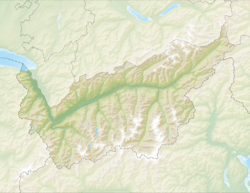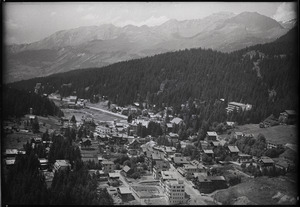Montana, Switzerland facts for kids
Quick facts for kids
Montana
|
||
|---|---|---|
 |
||
|
||
| Country | Switzerland | |
| Canton | Valais | |
| District | Sierre | |
| Area | ||
| • Total | 4.9 km2 (1.9 sq mi) | |
| Elevation | 1,495 m (4,905 ft) | |
| Population
(December 2007)
|
||
| • Total | 2,276 | |
| • Density | 464/km2 (1,203/sq mi) | |
| Postal code |
3963
|
|
| Surrounded by | Chermignon, Lens, Randogne, Sierre | |
Montana was once a small town, or municipality, in the Valais area of Switzerland. It was known as one of the six towns that made up the popular ski resort Crans-Montana. The other towns were Icogne, Lens, Randogne, Mollens, and Chermignon.
On January 1, 2017, Montana joined with Chermignon, Mollens (VS), and Randogne. They all became part of a new, larger town called Crans-Montana.
Contents
History of Montana
When was Montana first mentioned?
Montana's name first appeared in records in the year 1243. It was simply called Montana back then.
How did Montana become its own town?
For a long time, Montana was part of another town called Lens. But in 1905, Montana became its own independent municipality. This meant it could make its own decisions and manage its own affairs.
Geography of Montana
Where is Montana located?
Montana is located in the Sierre district of Switzerland. It sits high up, on the right side of the Rhone River.
What is the land like in Montana?
In 2009, Montana covered an area of about 4.9 square kilometers (1.9 square miles). Here's how the land was used:
- About 25.8% was used for farming.
- Around 42.5% was covered by forests.
- About 28.6% had buildings or roads.
- A small part, 1.6%, was rivers or lakes.
- About 2.0% was land that couldn't be used for farming or building.
Most of the built-up areas were homes and other buildings. A smaller part was for roads and transportation. Parks and sports fields also took up some space. In the forests, most trees were dense, but some areas had small groups of trees or orchards.
What villages and resorts are in Montana?
The former town of Montana included:
- The main villages of Montana and Corin.
- Part of an area called Champzabé.
- A small village, or hamlet, named Diogne.
- Part of the Montana-Vermala resort, which is a popular spot for visitors. This resort is about 1,500 meters (4,900 feet) high and is shared with the town of Randogne.
Coat of Arms
What does Montana's coat of arms look like?
A coat of arms is a special design that represents a town or family. Montana's coat of arms has a red background. On it, you can see two golden shepherd's staffs crossed over each other. Below them, a green pine tree grows from green hills. The tree's trunk is red.
People of Montana (Demographics)
How many people lived in Montana?
In 2015, Montana had a population of 2,363 people. In 2008, about 27.8% of the people living there were from other countries.
What languages do people speak?
In 2000, most people in Montana spoke French as their main language (about 81.7%). The next most common language was German (5.4%), followed by Italian (4.7%).
Where were people born?
In 2000, about 35.6% of the people living in Montana were born there. Another 21.4% were born in the same canton (Valais). About 11.6% were born elsewhere in Switzerland, and 27.7% were born outside of Switzerland.
What are the age groups in Montana?
In 2000, the population of Montana included:
- Children and teenagers (0–19 years old): 20.8%
- Adults (20–64 years old): 62%
- Seniors (over 64 years old): 17.2%
How has the population changed over time?
The chart below shows how Montana's population has grown and changed over many years.

Important Buildings
What is the Hotel Bella Lui?
The Hotel Bella Lui is a very important building in Montana. It is listed as a Swiss heritage site of national significance. This means it's a special place that is protected because of its history or design.
Economy of Montana
What kind of jobs were there in Montana?
In 2010, Montana had an unemployment rate of 4%. This means 4% of people who wanted to work couldn't find a job.
In 2008, people in Montana worked in different types of jobs:
- Primary sector: 64 people worked in jobs like farming. There were 29 businesses in this area.
- Secondary sector: 206 people worked in jobs like manufacturing (making things) or construction (building things). There were 23 businesses in this area.
- Tertiary sector: 1,054 people worked in service jobs. This includes things like working in shops, hotels, restaurants, education, or healthcare. There were 135 businesses in this area.
Overall, 1,199 people in Montana had jobs, and about 46.3% of them were women.
How did people travel to work?
In 2000, many people traveled into Montana for work (1,250 workers). Fewer people traveled out of Montana for work (527 workers). This means Montana had more jobs than local workers. About 6.6% of workers used public transportation, and 55% used a private car to get to work.
Religion in Montana
What religions were common in Montana?
Based on a 2000 survey, most people in Montana were Roman Catholic (about 78.8%). About 6.9% belonged to the Swiss Reformed Church. Other groups included Orthodox Christians (3.95%) and other Christian churches (1.00%). There were also small numbers of Jewish people (0.43%) and Muslims (0.82%). A few people were Buddhist or belonged to other faiths. About 3.77% of the population said they had no religion, and 4.64% did not answer.
Climate in Montana
What is the weather like in Montana?
Montana has a climate that is often called a "marine west coast climate" (Cfb). This means it has mild temperatures and rain throughout the year.
Between 1991 and 2020, Montana had about 103.8 days of rain or snow each year. On average, it received about 834 millimeters (32.8 inches) of precipitation annually.
- Wettest month: December was the wettest month, with about 96 mm (3.8 inches) of rain or snow over 9 days.
- Most rainy days: June had the most days with precipitation (10.3 days), but less total rain (73 mm or 2.9 inches).
- Driest month: April was the driest month, with about 49 mm (1.9 inches) of precipitation over 7.5 days.
| Climate data for Montana (1991–2020) | |||||||||||||
|---|---|---|---|---|---|---|---|---|---|---|---|---|---|
| Month | Jan | Feb | Mar | Apr | May | Jun | Jul | Aug | Sep | Oct | Nov | Dec | Year |
| Mean daily maximum °C (°F) | 1.8 (35.2) |
2.4 (36.3) |
6.3 (43.3) |
10.2 (50.4) |
14.5 (58.1) |
18.5 (65.3) |
20.8 (69.4) |
20.3 (68.5) |
16.0 (60.8) |
11.7 (53.1) |
5.9 (42.6) |
2.6 (36.7) |
10.9 (51.6) |
| Daily mean °C (°F) | −1.6 (29.1) |
−1.5 (29.3) |
1.8 (35.2) |
5.2 (41.4) |
9.3 (48.7) |
13.1 (55.6) |
15.0 (59.0) |
14.8 (58.6) |
10.9 (51.6) |
7.2 (45.0) |
2.3 (36.1) |
−0.7 (30.7) |
6.3 (43.3) |
| Mean daily minimum °C (°F) | −5.3 (22.5) |
−5.5 (22.1) |
−2.5 (27.5) |
0.9 (33.6) |
4.7 (40.5) |
8.1 (46.6) |
9.9 (49.8) |
9.9 (49.8) |
6.5 (43.7) |
3.3 (37.9) |
−1.3 (29.7) |
−4.3 (24.3) |
2.0 (35.6) |
| Average precipitation mm (inches) | 76 (3.0) |
60 (2.4) |
53 (2.1) |
49 (1.9) |
78 (3.1) |
73 (2.9) |
80 (3.1) |
88 (3.5) |
55 (2.2) |
59 (2.3) |
67 (2.6) |
96 (3.8) |
834 (32.8) |
| Average snowfall cm (inches) | 95 (37) |
86 (34) |
48 (19) |
22 (8.7) |
2 (0.8) |
0 (0) |
0 (0) |
0 (0) |
0 (0) |
9 (3.5) |
38 (15) |
103 (41) |
403 (159) |
| Average precipitation days (≥ 1.0 mm) | 8.3 | 7.1 | 7.8 | 7.5 | 10.2 | 10.3 | 9.7 | 10.2 | 7.6 | 8.1 | 8.0 | 9.0 | 103.8 |
| Average snowy days (≥ 1.0 cm) | 8.9 | 7.9 | 5.7 | 3.2 | 0.3 | 0.0 | 0.0 | 0.0 | 0.0 | 1.3 | 5.3 | 8.7 | 41.3 |
| Average relative humidity (%) | 68 | 68 | 65 | 63 | 67 | 67 | 67 | 69 | 73 | 71 | 71 | 69 | 68 |
| Mean monthly sunshine hours | 134 | 142 | 182 | 189 | 199 | 220 | 243 | 230 | 199 | 167 | 121 | 116 | 2,141 |
| Percent possible sunshine | 54 | 54 | 56 | 53 | 49 | 55 | 59 | 60 | 60 | 56 | 48 | 50 | 55 |
| Source: MeteoSwiss | |||||||||||||
Education in Montana
How many people had higher education?
In Montana, about 32.3% of the population had finished upper secondary education. This is schooling after middle school. Also, about 15.4% had gone on to higher education, like a university or a specialized college (Fachhochschule).
Of those with higher education, about 39.9% were Swiss men, 28.9% were Swiss women, 18.5% were non-Swiss men, and 12.6% were non-Swiss women.
Where did students go to school?
In 2000, 507 students who lived in other towns came to Montana for school. At the same time, 144 students from Montana went to schools outside the town.
See also
 In Spanish: Montana (Valais) para niños
In Spanish: Montana (Valais) para niños





